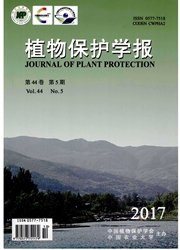

 中文摘要:
中文摘要:
采用Wolbachia的通用引物及A和B大组特异性引物对蝶蛹金小蜂Pteromalus puparum和丽蝇蛹集金小蜂Nasonia vitripennis体内Wolbachia的wsp基因进行PCR扩增及序列测定,并对测定的序列进行了同源性比较和基因特征分析。结果表明:蝶蛹金小蜂和丽蝇蛹集金小蜂均被A和B两个大组的Wolbachia复合感染;同种寄生蜂的雌蜂和雄蜂的wsp基因片段序列完全一致。采用通用引物从蝶蛹金小蜂中扩增出Wolbachia的wsp基因片段序列的长度为540bp,属于B大组中Pip组,而从丽蝇蛹集金小蜂中扩增出Wolbachia的wsp基因片段序列的长度为558bp,属于A大组中Uni组。用A-Wolbachia引物从蝶蛹金小蜂和丽蝇蛹集金小蜂中扩增出的wsp基因片段序列长度为548bp,同源性达99.8%;而用B-Wolbachia引物从两者中扩增的两条wsp基因片段序列长度分别为424bp和439bp同源性达87.5%.
 英文摘要:
英文摘要:
Polymerase chain reaction (PCR) amplification of a portion of a gene encoding a surface protein of Wolbachia (wsp) was used to detect the Wolbachia infection of the population of Pteromalus puparum and Nasonia vitripennis by universal primers of wsp gene and the specific primers for wsp genes of A and B Wolbachia supergroup. The PCR products were cloned, sequenced and analysed. The results demonstrated that both species were infected with strains of A and B Wolbachia, and wsp gene sequences of females and males from the same wasp were identical. By a pair of universal primers, a region of 540 bp of Wolbachia wsp gene were amplified from both of P. puparum females and males, likewise a region of 558 bp from N. vitripennis. The strains of Wolbachia, which infected P. puparum and N. vitripennis, were classified as the Pip group of B-1Volbachia and Uni group of A-Wolbachia, respectively. Both 548 bp regions of A-Wolbachia were amplified from these two wasps, and the sequence percent identity was 99.8%. In contrast, the 424 bp and 439 bp regions of B-Wolbachia were respectively amplified from P. puparum and N. vitripennis, and their sequence percent identity was 87.5%.
 同期刊论文项目
同期刊论文项目
 同项目期刊论文
同项目期刊论文
 期刊信息
期刊信息
